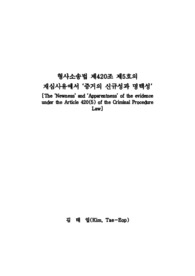

-
미리보기
서지정보
· 발행기관 : 사법발전재단
· 수록지 정보 : 사법 / 1권 / 11호 / 279 ~ 348페이지
· 저자명 : 김태업
초록
이 글은 대법원 2009. 7. 16.자 2005모472 전원합의체 결정에 관한 글이다.
위 결정은 형사소송법 제420조 제5호의 ‘무죄 등을 인정할 명백한 증거가 새로 발견된 때’라는 재심사유에서 증거의 신규성과 명백성과 관련된 쟁점을 모두 담고 있다는 데에 그 의의가 있다.
먼저, 위 결정은 위 조항에서 증거의 신규성에 있어서는 기왕의 판례에 따라 재심을 청구하는 피고인에게 해당 증거의 제출에 관한 고의ㆍ과실 등 귀책사유에 의하여 그 신규성을 제한적으로 해석하는 법원ㆍ재심청구인 기준설을 유지하였다. 다만, 위 결정에서 별개의견이 주장한 법원기준설과 법원ㆍ재심청구인 기준설에 대한 문제 제기는 앞으로의 실무 운영에서 유의하여야 할 대목이라고 생각된다.
다음으로, 위 결정은 무죄 등을 인정할 명백한 증거에 해당하는지 여부를 판단하는 데에 있어서 판단의 대상이 되는 증거의 범위에 대하여는 새로 발견된 증거만을 독립적ㆍ고립적으로 고찰하여 그 증거가치만으로 재심의 개시 여부를 판단하도록 한 기존의 판례 견해(고립평가설)를, 재심대상이 되는 확정판결을 선고한 법원이 사실인정의 기초로 삼은 증거들 가운데 새로 발견된 증거와 유기적으로 밀접하게 관련되고 모순되는 것들은 함께 고려하여 평가하도록 하는 제한적 평가설로 변경하였다는 점에서 그 의의가 크다. 다만, 이러한 제한적 평가설의 내용도 일반적이고 추상적이라 할 것이므로 향후 실무운영을 통해 그 내용이 구체화될 것으로 기대된다.
마지막으로, 위 결정은 무죄 등을 인정하기에 명백한 증거인지 여부에 관한 심증의 정도에 대하여는, “단순히 재심대상이 되는 유죄의 확정판결에 대하여 그 정당성이 의심되는 수준을 넘어 그 판결을 그대로 유지할 수 없을 정도로 고도의 개연성이 인정되는 경우”라고 판시하여 그동안 판례에서 제시된 엄격설을 보다 구체적으로 설명하고 있고, 재심개시여부를 심리하는 절차에는 ‘의심스러울 때는 피고인의 이익으로(in dubio pro reo)‘라는 원칙이 적용되지 않는다는 점을 분명히 하였다.
위 결정이 형사재심과 관련된 실무운영에 지침이 될 뿐만 아니라, 이를 계기로 재심제도 전반에 대한 활발한 논의가 이루어지기를 기대한다.영어초록
This thesis is regarding the decision of the Supreme Court on 2009.7.16., 2005mo472. The decision is meaningful in including all the issues related to ‘newness’ and ‘apparentness’ under such a ground for post-conviction relief as ‘it is newly discovered evidence apparent enough to acknowledge innocence’ under sec.420.no.5.
First of all, the object-mentioned decision, pursuant to precedent decisions, maintains, in terms of ‘newness of evidence’ under the section, the court-and-post-conviction-relief-petitioner standard theory which adopts such restrictive construction as to ‘newness of evidence’ by considering the recklessness and negligence in submitting evidence of the accused who places petition for a post-conviction relief. However, a court-standard theory and criticism for the court-and-post-conviction-relief-petitioner standard theory, propounded by a concurring opinion, are noteworthy in the future operation of practices to come.
Next, the object-mentioned decision is significant in shifting existent holdings, which independently and isolatedly examine newly-discovered evidence as regards the range of evidence as the object of judgment in terms of deciding whether it falls on evidence so apparent to acknowledge innocence, to the restrictive assessment theory, which allows a court of a final decision to consider and assess the closely related and inconsistent things as well as newly discovered evidence among evidences for the foundation of fact-finding. However, it is expected that contents of the restrictive assessment theory will take a firm root through operating future practices as the theory itself is abstract and general.
Finally, the object-mentioned decision held, as regards the level of the suspicion whether evidence is apparent enough to acknowledge innocence, “the standard where it is acknowledged that there is such high probability that a court cannot maintain the decision beyond a level of mere doubt on legitimacy of the final judgment of being guilty as the object of a post-conviction relief.” Thereby, it explained in a more concrete way a strict theory suggested by former decisions, and confirmed the fact that ‘in dubio pro reo’ principle is not applicable to the procedure deciding whether a court approves a post-conviction relief.
The object-mentioned decision is expected not only to serve as a guideline for practices related to a post-conviction relief in criminal procedure, but also to provoke rigorous discussions for the overall institution of the post-conviction relief.참고자료
· 없음태그
- # 재심
- # 증거의 신규성
- # 증거의 명백성
- # 법원
- # 재심청구인 기준설
- # 법원기준설
- # 엄격설
- # 완화설
- # 고립평가설
- # 제한적 평가설
- # 종합평가설
- # post-conviction relief
- # newness of evidence
- # apparentness of evidence
- # a court-and-post-conviction-relief-petitioner standard theor
- # a court-standard theory
- # a strict theory
- # an alleviated theory
- # isolated assessment theory
- # restrictive assessment theory
- # overall assessment theory
-
자주묻는질문의 답변을 확인해 주세요

꼭 알아주세요
-
자료의 정보 및 내용의 진실성에 대하여 해피캠퍼스는 보증하지 않으며, 해당 정보 및 게시물 저작권과 기타 법적 책임은 자료 등록자에게 있습니다.
자료 및 게시물 내용의 불법적 이용, 무단 전재∙배포는 금지되어 있습니다.
저작권침해, 명예훼손 등 분쟁 요소 발견 시 고객센터의 저작권침해 신고센터를 이용해 주시기 바랍니다. -
해피캠퍼스는 구매자와 판매자 모두가 만족하는 서비스가 되도록 노력하고 있으며, 아래의 4가지 자료환불 조건을 꼭 확인해주시기 바랍니다.
파일오류 중복자료 저작권 없음 설명과 실제 내용 불일치 파일의 다운로드가 제대로 되지 않거나 파일형식에 맞는 프로그램으로 정상 작동하지 않는 경우 다른 자료와 70% 이상 내용이 일치하는 경우 (중복임을 확인할 수 있는 근거 필요함) 인터넷의 다른 사이트, 연구기관, 학교, 서적 등의 자료를 도용한 경우 자료의 설명과 실제 자료의 내용이 일치하지 않는 경우
“사법”의 다른 논문도 확인해 보세요!
-
우리나라 부동산세제에 있어서의 입법정책의 문제점 39 페이지
우리나라의 부동산세법은 부동산에 대한 납세인의 행위에 따라 납세의무가 발생하는 조세를 규정하는 법이다. 따라서, 소득세나 소비세보다도 행위의 객체인 부동산의 물건적 속성에 보다 많은 초점을 두게 되는 조세라는 특징을 갖게 된다. 특히 우리나라는 부동산시장대책으로 조세정책을 적극적으로 수단화하는 정책당국의 태도에 영향을 받아, 가격안정이나 소유구조 집중완화와.. -
법인 아닌 사단에 유추 적용되는지 여부와 종교단체에서의 제한 가능성 (대상결정 : 대법원 2009. 11. 19.자 2008마.. 45 페이지
대상결정은 임시이사 선임에 관한 민법 제63조가 법인 아닌 사단에도 유추 적용되는지 여부와 관련하여 이를 부정한 종전의 대법원결정을 변경함과 동시에 대상 단체가 종교단체인 경우에는 위와 같은 임시이사 제도의 적용이 제한됨을 판시하고 있다. 대법원의 확립된 견해는, 민법은 법인 아닌 사단의 법률관계에 관하여 재산의 소유 형태 및 관리 등을 규정하는 제275조..
문서 초안을 생성해주는 EasyAI

